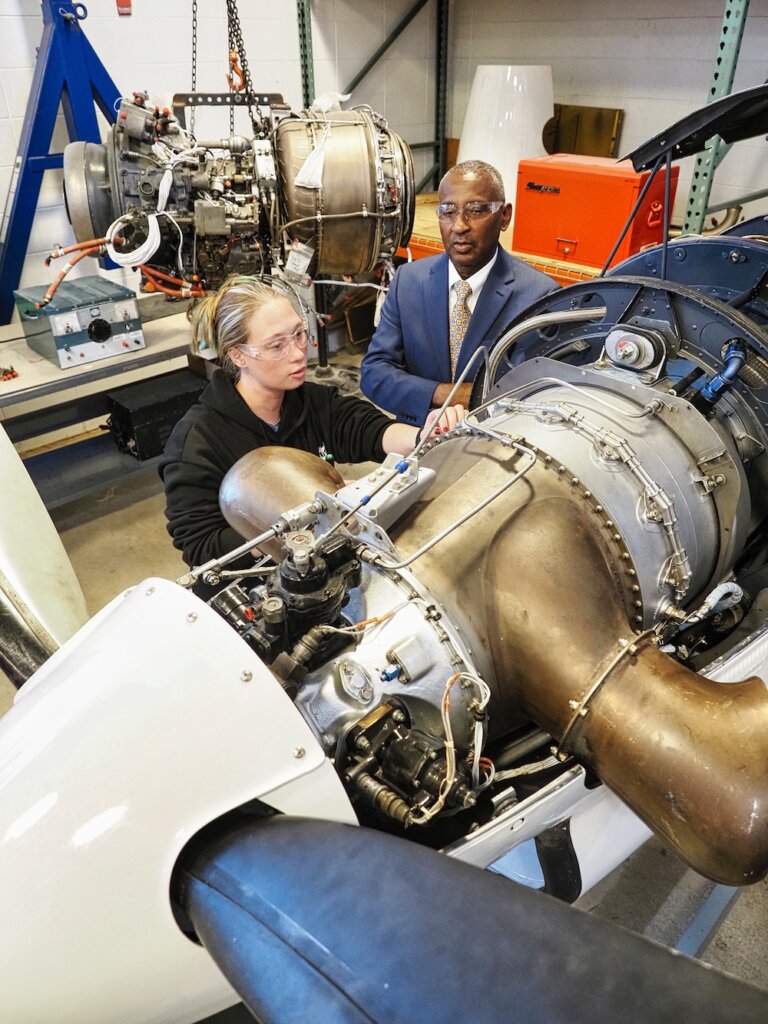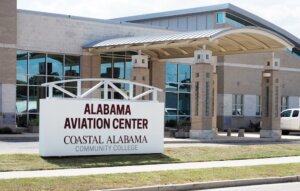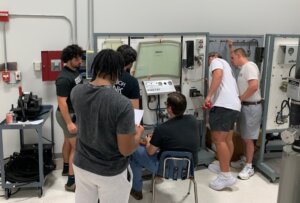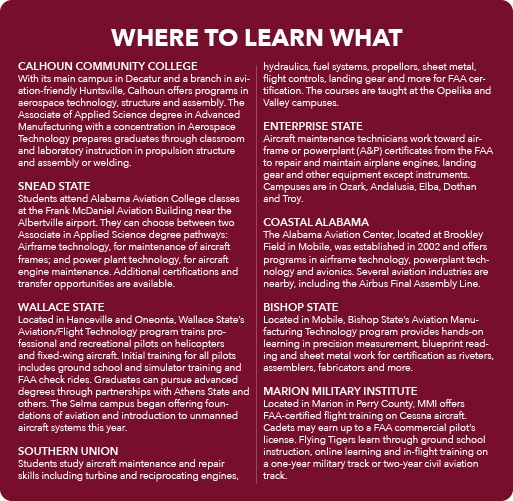
Boeing estimates that more than 600,000 new maintenance technicians will be needed over the next 20 years to service the global commercial aviation fleet – 134,000 in North America alone.
The Alabama Community College System is doing its part. Before the fall semester began this year, more than 1,200 students already had enrolled in flight technology, aviation maintenance and aviation manufacturing programs at eight state community colleges.
The aerospace and aviation programs include advanced composites, aerospace welding, aircraft structural assembly, avionics, flight simulation, drone technology, robotics and more.
The courses train students in career paths certified by the Federal Aviation Administration and Southern Association of Colleges and Schools.
Gillette Samms is director of aviation programs for the Alabama Community College System. In his lilting accent, he tells the interesting story of how he came to Alabama in the 1970s and ended up overseeing the community college program decades later.
“I’m originally from Jamaica,” Samms says. “My first trip on an airplane landed in Dothan, Alabama. That school was a magnetic draw not just nationwide, but there were a whole lot of foreign students there when I attended it.”
Jamaica did have its own airline, but he came to America for the best training available.
“I’ve always dreamed of doing aviation,” he says. “As with most young kids growing up, you aspire for an aviation career but realistically it was probably outside of my league financially and otherwise.”
Sponsorships were available in different professions at U.S. companies then, including the field of aviation mechanics.
“They were attracting folks from overseas to train in the U.S. and I responded to it,” he says. “I was lucky to be one of the candidates that got accepted and ended up in Ozark.”
Samms graduated in 1979 and worked at Dannelly Field in Montgomery for about a year, and later at Northrop Grumman. He earned his pilot’s license, became a flight instructor, taught aviation tech for 28 years at Atlanta Technical College and later in Utah and North Carolina. He started an aviation program in Crestview, Florida, too.

Samms took over leadership of Alabama’s training program about two-and-a-half years ago. The state already had deep roots in aviation – both military and space. The Wright Brothers opened the first civilian aviation school in Montgomery in 1910.
“Ozark is one of the most successful programs in the state,” says Samms. “They’re in the back door of Fort Rucker, or Fort Novosel, and they’re sort of like a feeder for that whole operation down here for the U.S. Army.”
The U.S. Army helicopter training center began in Ozark in 1971 and is one of the largest in the world.
“They hold the name Alabama Aviation College,” he says.
“I actually worked there when I graduated,” Samms says. “I spent about five years maintaining helicopters there. They’re primarily helicopters but they do have fixed-wing aircraft as well, strictly military.”
Depending on the program, the community college curriculum prepares graduates for the federal aviation mechanics test in two divisions. The airframe license deals with structural components, electrical equipment, landing gear and more. The power plant license pertains to engines.
“Avionics is essentially aircraft electronics,” he says, including instrumentation, navigation, radios and communication.
“The technical skills that they gain is to make them qualify for the test for the FAA license,” he says. “The license is basically the passport for getting into the profession.”
Samms is working to expand avionics offerings at community colleges across the state.
Because of attrition, retirement and expansion in the industry, there’s a great need for pilots and maintenance personnel, he says.
Samms is based in south Alabama “because of the growing demand for Airbus and the training that Bishop State College is doing currently for Airbus,” he says. He travels across the state to visit the various programs.
After general instruction, students study aircraft structure “where they do sheet metal structure, sheet metal repairs. They have to learn about the different fasteners that are used, the application of these fasteners and different structural repairs on the aircraft. You don’t just go out and grab some metal and just slap it on the side of the aircraft.
“They do things like basic electricity. They learn about fluid lines and fit-ins. They learn about hydraulics. They learn to read precision instruments and tools,” he says.
On the electrical side, students learn to install instruments, calculate voltage and loads, and troubleshoot air conditioning, pressurization and instrument systems using technical and engineering manuals.
“They actually weigh an aircraft and come up with the data that the pilot will have to use when they go flying – when they load the aircraft with passengers and a car on board, they have to calculate the center of gravity of the aircraft to make sure it falls within limits,” Samms says.

One thing students learn is the importance of personally signing off on every step in the maintenance process.
When he speaks to students, he instills the idea that “you should be able to put your mom and your child and whoever on there and be comfortable doing it.”
The program is thorough because “everything is critical,” he says. “Anything that is on the aircraft other than the cockpit instrumentation, they are required to learn how to fix.”
The state’s Aviation College program has an articulation agreement with Embry-Riddle Aeronautical University in Florida to train students beyond the two-year level. Athens State University offers a transfer opportunity for a major in management of technology with a minor in aviation management.
Southern Union State Community College has partnered with Auburn University to build a new hangar at Auburn University Regional Airport to expand its maintenance program and support the Auburn School of Aviation.
High school students around the state are taking advantage of training opportunities through dual enrollment.
Samms likes to introduce high school students to aviation careers because “one of the biggest things I find is it’s the best-kept secret,” he says. “Nobody knows about aviation, unless mom or dad work in the field. I’m really working on pushing it in all the high schools regionally across the state.”
Students who complete the program are almost certain to find work, he says.
“There’s a job out there for those who graduate out of the aviation maintenance program,” he says. “They may have to go out of state and several of them do.”
He likes to make potential students aware that “we’ve got this out here. You can live good. The earning potential is great. It’s on par with people leaving colleges with a four-year degree.”
Some of his former students say they’re making as much as $80,000 a year. “And this was years ago,” he says.
On a side note, Samms says that many people inside the state don’t realize that Alabama’s job training program is nationally respected.
The state is “the tip of the spear when it comes to skills, trade training and innovative programs in workforce training,” he says.
College presidents often ask him how to start aviation programs on their own campuses.
“I say, ‘Listen. Have you got about $5 million to $6 million to start with?’,” Samms says with a laugh.

Deborah Storey and Mike Kittrell are freelance contributors to Business Alabama. She is based in Huntsville and he in Mobile.
This article appears in the October 2025 issue of Business Alabama.



